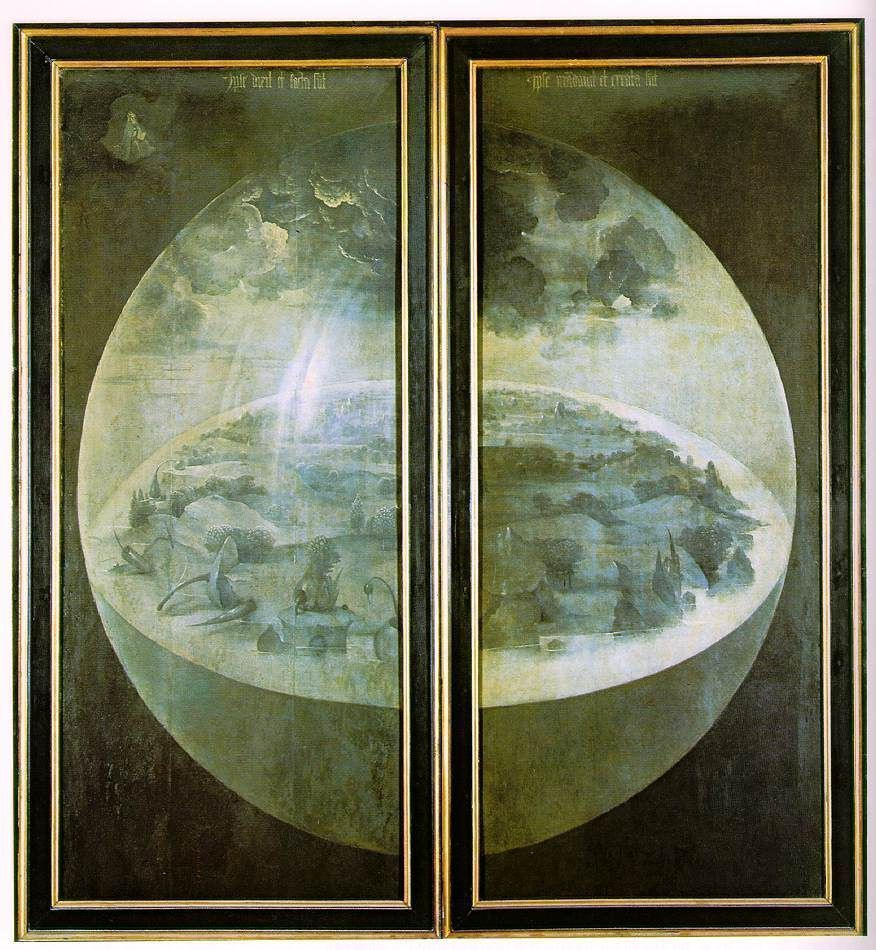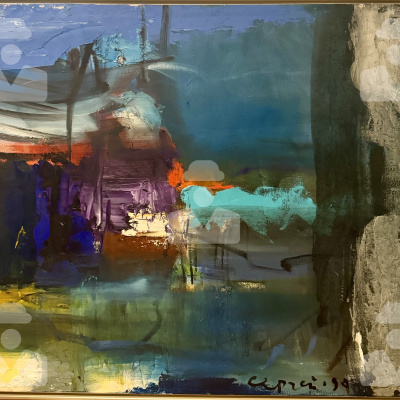Probably in the history of art we have never met a character whose personality would stir such kind of a public interest and at the same time would be covered with so heavy fog. We know little about Hieronymus Bosch; historians even do not know the exact date of his birth. However, audacious hypothesis would reign if facts are not enough.


Bosch’s life history in a way is like his famous triptych The Garden of Earthly Delights. When it is closed it is just a modest monochrome list of archive documents. But as soon as art experts open panels of their imagination a little, the life of Bosch will flourish with breathtaking events, colors and images.
Who was this man in reality? Could he be a Messiah, Antichrist, visionary, lunatic or all at once? Here are some popular hypotheses exciting minds of a lot of scholars during several centuries.
Who was this man in reality? Could he be a Messiah, Antichrist, visionary, lunatic or all at once? Here are some popular hypotheses exciting minds of a lot of scholars during several centuries.
Secret heretic
In the XVI century people started talking about Bosch’s artworks as touched by heresy and today this hypothesis is still under consideration. In general, its supporters are divided into two camps. The one regards him to be a member of the Adamites sect, which is also called the Brethren of the Free Spirit whose members practiced social and religious nudity, free love and rejected marriage and individual ownership of property, proclaiming new Eden on the Earth with equality of everybody, innocence and happiness like Adam and Eve had been. Some scholars take the central part of the triptych "The Garden of Earthly Delights" as an evidence of the religious services practiced by the Adamites and depicted by Bosch (German art historian Wilhelm Fraenger actively lobbied the hypothesis in particular).The others are sure that teeming with nude figures required by the painter to demonstrate his contempt for pleasure of the flesh. For instance, Linda Harris, a biographer, thinks that behind Bosch’s heresy stood the doctrines and attitudes of Catharism and Manichaeism with their clear defined dualism (as the result, the apparent separation of Light from Darkness, heaven from hell, spiritual from material).
The both stubbornly ignore the fact that at the times of Bosch the inquisition zealots violently raged; and the one who tried to run along the streets of Hertogenbosch nude proclaiming free love or duality of the Universe (even not in the street but in the allegorical manner of painting) could reach the nearest rack only.
Strong catholic
While some biographers are arguing what particular heresy has been Bosch’s devotion, the others are sure that he has been a strong Catholic, as one says today:"a true Catholic". The anticlerical pathos in his artworks was the result of the Throne mild attitude to the Adamites, Manichaeism devotees, Humanitarians and other sinners.Bosch lived in the epoch of the Great Turn. Trends of hedonism, drifting in Italy, reached Northern Europe. Poverty, humbling and modesty were the ideals having been reigned for centuries and suddenly quaked under the weight of a seditious idea that a man is an "apex of creation". The authority of the Church was eroded and Bosch clearly understood that the day of reckoning was coming. He exemplary painted ubiquitous frogs and owls related to darkness and heresy. He depicted degraded priests as he thought the Church was also obsessed by greediness and filth. His fantastical figures in The Garden of Earthly Delights and not only were inspired by his pure feeling of the Catholic guilt but not the heretical doctrines.
After Bosch’s death the funeral service was performed in the St. Johann cathedral paying high tribute to him and the fact supported this theory. The other evidence in favor of the theory is that Bosch’s painting The Seven Deadly Sins was in the privy chamber of Philip II of Spain, the monarch who violently persecuted heretics.
Practising alchemist
The central part of the triptych The Garden of Earthly Delights is often called "the alchemist’s garden" with its numerous astrological symbols, coupling in glass spheres (read: flasks and retorts) and essential Fountain of Youth — certainly, the alchemist contents. Bosch’s attitude to alchemy is treated differently.For example, Jacques Chailley, a French researcher of Bosch’s oeuvre, mentions Bosch as a biased witness of one of the most significant stage of the alchemist art. At the same time, Chailley states that Bosch was a bitter enemy of alchemy, considered it to be heresy and the object of satire. The others claim that Bosch was not only a biased witness but exercised alchemy himself. This theory seems to be true; a lot of painters try to obtain gold with the reaction between a canvas and paints (sometimes a catalyst of such reaction could be a talent and sometimes it appeared to be a cheating art dealer). Though, it has nothing to do with Bosch; he got married to a rich girl and had no need to work for money.
Visioner
A lot of people are sure that fantastic imagery of Bosch was the result of his sick fantasies in the altered state of consciousness. Though, there is no general idea about the nature of such fantasies.Somebody intends to make a diagnosis for Bosch. So, famous Russian psychiatrist Mark Bruno mentioned that Bosch’s creative work had a polyphonic character, peculiar characterological mosaics generated by a schizophrenic process.
Few facts are known from his life story showed that Bosch’s life was upsetting routine and even dull. Moreover, the modern psychiatry says that one in ten persons suffers from some kind of mental disorders and one in three artists in the world of arts. So, we can say that this hypothesis could be true to the extent of consolation for the "masters of culture" with poor imagination.
Some people think that Bosch likely took recreational drugs for deeper immersion into the theme. Nowadays it is difficult to believe that the Dutch painter could have some difficulties with that. However, at the times of Bosch there were not so many coffee shops. We also do not have any documentary evidences that trance parties or psychedelic open air parties were held in Hertogenbosch in the XV century. In general, the culture of hallucinogen consumption was not developed that time. .
The other hypothesis holds that Hieronymus Bosch sold his soul to the devil for the opportunity to travel to another worlds. Though the scientific community does not consider it seriously.
Extraterrestrial
When Dutch professor of iconography Edmund van Hoose examined the decorations of one of the cathedrals in Hertogenbosch performed by Bosch, he arrived at the conclusion that Hieronymus witnessed UFO. However, American ufologist Jordan Hards regards the Hoose’s theory not grounded enough. He thinks that that Bosch could not witness UFO in the XV century because it is an unscientific nonsense: the plain truth is that Bosch was an alien. Forget metaphors and allegories: Bosch was realist. Flying fish? Learned grasshoppers? Melancholic wooden monster with jolly banqueters inside its belly? In the place where Bosch was born it was a routine practice.Performer of customers' fantasies
At last, the hypothesis which seems to be true. Bosch liked to make riddles for the public, he enjoyed numerous renderings and meanings which the public saw in his artworks. He was attentive to customers' wishes and honestly implemented their fantasies (especially when a customer was a respectable nobleman). At the same time he managed to keep an intrigue for the nobleman making sense of a conundrum made a fool of himself.The iconography of The Garden of Earthly Delights was partially dictated by its religious contents and also was calculated for a powerful visual effect. As may well be imagined how Henri III, who owned the artwork that time, impressed his guests when he opened dark panels of the triptych. Bosch was a polyglot in a way, he could interpret any language. In his characters he ciphered biblical subjects, satirical hints and profusely local folklore of that time. So, the fragment with lovers in a glass sphere in the central panel could symbolize the Fall, could be deemed as a promotion of Adamites and their criticism at the same time, could be read as the alchemist allegory and could be also the illustration of the Dutch saying "Glass and Love are so fragile".
Sphere is not so important, the figure of fish could embody Christ, a star sign, the Moon, February, water, phlegmatic temperament, an attribute of lust, a symbol of Lent or at the same time could hint on the Dutch proverbs "A big fish eats a small one" or "Each herring is hanged by its own tail".
Except the cases when a fish meant a fish like it was.
The title illustration: The Garden of Earthly Delights. The Creation. Outer panels
Author: Andrei Zimogliadov
Author: Andrei Zimogliadov



















